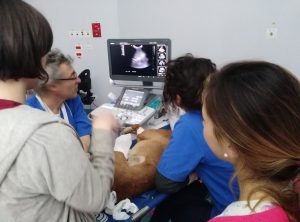Diagnostic value of Light’s criteria and albumin gradient in classifying the pathophysiology of pleural effusion formation in cats
Zoia A1, Drigo M2.
Diagnostic value of Light’s criteria and albumin gradient in classifying the pathophysiology of pleural effusion formation in cats
J Feline Med Surg. 2016 Aug;18(8):666-72. doi: 10.1177/1098612X15592170. Epub 2015 Jun 26.
Abstract
The primary aim of this study was to assess whether human Light’s criteria with the cut-off values previously published for cats are useful and superior to the traditional veterinary classification in diagnosing pathophysiology of fluid formation in cats with pleural effusion. The secondary aim was to assess if the albumin gradient (ALBg) is a reliable criterion for differentiating exudates from transudates in patients with pleural effusion thought to be transudative by clinical criteria but identified as exudative by Light’s criteria. Nineteen client-owned cats with pleural effusion were studied. The aetiology of the pleural effusion was used to establish the pathophysiology of its formation. Parameters measured or calculated undergoing statistical analysis included Light’s criteria, total protein and total nucleated cell count in the pleural effusions, and the ALBg. Based on the pathophysiology of fluid formation there were seven transudates caused by increased hydrostatic pressure and 12 exudates. There was a significant difference in the accuracy of the Light’s criteria in correctly classifying origin of the pleural fluid formation compared with the traditional veterinary classification (84% vs 53%). ALBg values were significantly different between transudates and exudates. One of the three transudates misclassified as exudates by Light’s criteria was correctly identified as a transudate by the ALBg. In conclusion, pleural effusion should be classified as either a transudate or an exudate using Light’s criteria. In cats with pleural effusion thought to be transudative by clinical criteria, but identified as exudative by Light’s criteria, the ALBg may further help in correctly differentiating exudates from transudates.






 Il Direttore Sanitario Dott. Marco Caldin
Il Direttore Sanitario Dott. Marco Caldin